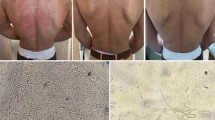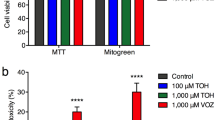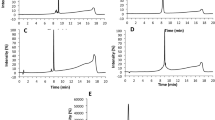Abstract
Onychomycosis, a superficial fungal infection of the nails, is prevalent in many areas of the world. Topical agents for onychomycosis need to reach the subungual layer and nail bed to exert antifungal activity in the presence of keratin, the major component of the nail. It is difficult to evaluate the efficacy and pharmacodynamics of topical agents for onychomycosis in a non-clinical evaluation system. No consistent animal model has yet been established to predict the efficacy of topical agents for onychomycosis. In this study, we evaluated the pharmacokinetics and pharmacodynamics of ME1111 in a guinea pig model of tinea corporis designed to predict the efficacy of topical medication for onychomycosis in the vicinity of the nail bed. Trichophyton mentagrophytes TIMM1189 was infected on the back skin of guinea pigs, and ME1111 solution (5%, 10%, or 15%) was administered topically, once daily for 14 consecutive days. Following the completion of dosing, segments of skin from the site of infection were excised and cultured. The concentration of ME1111 in the back skin of guinea pigs increased with formulation concentration and correlated with mycological efficacy. We revealed the concentration required for ME1111 to be effective at the site of infection. Further analysis is needed to predict the efficacy of topical agents for onychomycosis by analyzing the relationship between PK/PD around the nail bed and factors such as subungual penetration and permeability.
This is a preview of subscription content, access via your institution
Access options



Similar content being viewed by others
References
Ghannoum MA, Hajjeh RA, Scher R, Konnikov N, Gupta AK, Summerbell R, et al. A large-scale North American study of fungal isolates from nails: the frequency of onychomycosis, fungal distribution, and antifungal susceptibility patterns. J Am Acad Dermatol. 2000;43:641–8.
Gupta AK, Jain HC, Lynde CW, Macdonald P, Cooper EA, Summerbell RC. Prevalence and epidemiology of onychomycosis in patients visiting physicians’ offices: a multicenter Canadian survey of 15,000 patients. J Am Acad Dermatol. 2000;43:244–8.
Heikkilä H, Stubb S. The prevalence of onychomycosis in Finland. Br J Dermatol. 1995;133:699–703.
Ghannoum M, Isham N. Fungal Nail Infections (Onychomycosis): A never-ending story? PLoS Pathog. 2014;10:e1004105.
Elewski BE. Onychomycosis. Treatment, quality of life, and economic issues. Am J Clin Dermatol. 2000;1:19–26.
Alley MRK, Baker SJ, Beutner KR, Plattner J. Recent progress on the topical therapy of onychomycosis. Expert Opin Investig Drugs. 2007;16:157–67.
Tabata Y, Takei-Masuda N, Kubota, Takahata S, Ohyama M, Kaneda K, et al. Characterization of antifungal activity and nail penetration of ME1111, a new antifungal agent for topical treatment of onychomycosis. Antimicrob Agents Cheomother. 2015;60:1035–9.
Ghannoum M, Isham N, Long L. In vitro antifungal activity of ME1111, a new topical agent for onychomycosis, against clinical isolates of dermatophytes. Antimicrob Agents Chemother. 2015;59:5154–8.
Kubota-Ishida N, Takei-Masuda N, Kaneda K, Nagira Y, Chikada T, Nomoto M, et al. In vitro human onychopharmacokinetic and pharmacodynamic analyses of ME1111, a new topical agent for onychomycosis. Antimicrob Agents Chemother. 2017;62:e00779–17.
Takei-Masuda N, Nagira Y, Kaneda K, Chikada T, Nomoto M, Tabata Y, et al. Potent antifungal activity of ME1111 against Trichophyton species in the presence of keratin [abstract F-742] 55th Intersci Conf Antimicrob Agents Chemother 2015.
Cecchini G. Function and structure of complex II of the respiratory chain. Annu Rev Biochem. 2003;72:77–109.
Takahata S, Kubota N, Takei-Masuda N, Yamada T, Maeda M, Alshahmi MM, et al. Mechanism of action of ME1111, a novel antifungal agent for topical treatment of onychomycosis. Antimicrob Agents Chemother. 2016;60:873–80.
Hui X, Jung EC, Zhu H, Maibach H. Antifungal ME1111 in vitro human onychopharmacokinetics. Drug Dev Ind Pharm. 2017;43:22–9.
Murdan S. Drug delivery to the nail following topical application. Int J Pharm. 2002;236:1–26.
Sugiura K, Sugimoto N, Hosaka S, Katafuchi-Nagashima M, Arakawa Y, Tatsumi Y, et al. The low keratin affinity of efinaconazole contributes to its nail penetration and fungicidal activity in topical onychomycosis treatment. Antimicrob Agents Cheomother. 2014;58:3837–42.
Pollak RA, Siu WJJ, Tatsumi Y, Pillai R. Efinaconazole topical solution, 10%: factors contributing to onychomycosis success. J Fungi (Basel). 2015;1:107–14.
Tatsumi Y, Yokoo M, Senda H, Kakehi K. Therapeutic efficacy of topically applied KP-103 against experimental tinea unguium in guinea pigs in comparison with amorolfine and terbinafine. Antimicrob Agents Chemother. 2002;46:3797–801.
Hasegawa N, Shibuya K. Development of an Animal Model of Onychomycosis in Guinea Pigs. Med Mycol J. 2020;61:55–60.
Nakamura A, Hirakawa S, Nagai H, Inagaki K. A comparative study between two antifungal agents, Luliconazole and Efinaconazole, of their preventive effects in a Trichophyton-infected guinea pig onychomycosis model. Med Mycol. 2021;3:289–95.
Masumoto A, Sugiura K, Matsuda Y, Tachibana H, Tatsumi Y. Evaluation of topical antifungals using a new predictive animal model for efficacy against severe tinea unguium: a comparison of efinaconazole and luliconazole. Mycopathologia. 2022;187:481–9.
Shimamura T, Kubota N, Nagasaka S, Suzuki T, Mukai H, Shibuya K. Establishment of a novel model of onychomycosis in rabbits for evaluation of antifungal agents. Antimicrob Agents Chemother. 2011;55:3150–5.
Coronado D, Merchant T, Chanda S, Zane LT. In vitro nail penetration and antifungal activity of tavaborole, a boron-based pharmaceutical. J Drugs Dermatol. 2015;14:609–14.
Matsuda Y, Sugiura K, Hashimoto T, Ueda A, Konno Y, Tatsumi Y. Efficacy coefficients determined using nail permeability and antifungal activity in keratin-containing media are useful for predicting clinical efficacies of topical drugs for onychomycosis. PLoS One. 2016;11:e0159661.
Cashman MW, Sloan SB. Nutrition and nail disease. Clin Dermatol. 2010;28:420–5.
Winckle G, Fieldson GT Compositions and methods for treating diseases of the nail. United states patent application publication. US 2014/0228403 A1.
Reference Method for Broth Dilution Antifungal Susceptibility Testing of Filamentous Fungi, 2nd ed. approved standard. (M38-A2) Wayne PA: Clinical and Laboratory Standards Institute; 2008.
Niwano Y, Tabuchi T, Kanai K, Hamaguchi H, Uchida K, Yamaguchi H. Therapeutic efficacy of lanoconazole ointment in guinea pig model of tinea corporis, a comparative study with ointment and cream preparations. Jpn J Antibiot. 1995;48:150–4.
Lepak AJ, Andes DR. Antifungal pharmacokinetics and pharmacodynamics. Cold Spring Harb Perspect Med. 2014;55:a019653.
Elefanti A, Mouton JW, Krompa K, Al-Saigh R, Verweij PE, Zerva L, et al. Inhibitory and fungicidal effects of antifungal drugs against Aspergillus species in the presence of serum. Antimicrob Agents Chemother. 2013;57:1625–31.
Pressiat C, Ait-Ammar N, Daniel M, Hulin A, Botterel F, Levesque E. Pharmacokinetics/Pharmacodynamics of Caspofungin in Plasma and Peritoneal Fluid of Liver Transplant Recipients. Antimicrob Agents Chemother. 2022;66:e0118721.
Sobue S, Sekiguchi K, Nabeshima T. The pharmacokinetics of oral antifungal drugs and their efficacy against cutaneous mycosis. Nihon Yakurigaku Zasshi. 2005;125:291–5.
Long L, Hager C, Ghannoum M. Evaluation of the efficacy of ME1111 in the topical treatment of dermatophytosis in a guinea pig model. Antimicrob Agents Chemother. 2016;60:2343–5.
Watanabe S. Optimal dosages and cycles of itraconazole pulse therapy for onychomycosis. Jpn J Med Mycol 2004;45:143–7.
Hui X, Shainhouse JZ, Tanojo H, Anigbogu A, Markus G, Maibach HI, et al. Enhanced human nail drug delivery: nail inner drug content assayed by new unique method. J Pharm Sci. 2002;91:189–95.
Hui X, Baker SJ, Wester RC, Barbadillo S, Cashmore AK, Sanders V, et al. In vitro penetration of a novel oxaborole antifungal (AN2690) into the human nail plate. J Pharm Sci. 2007;96:2622–31.
Del Rosso JQ, Reece B, Smith K, Miller. Efinaconazole 10% solution: a new topical treatment for onychomycosis: contact sensitization and skin irritation potential. J Clin Aesthet Dermatol. 2013;6:20–4.
Elewski BE, Rich P, Pollak R, Pariser DM, Watanabe S, Senda H, et al. Efinaconazole 10% solution in the treatment of toenail onychomycosis: Two phase III multicenter, randomized, double-blind studies. J Am Acad Dermatol. 2013;68:600–8.
Yamaguchi H, Uchida K. Once daily administration of terbinafine to guinea-pigs with experimental dermatophytosis. Clin Exp Dermatol. 1989;14:108–9.
Lipner SR, Joseph WS, Vlahovic TC, Scher RK, Rich P, Ghannoum M, et al. Therapeutic recommendations for the treatment of toenail onychomycosis in the US. J Drugs Dermatol. 2021;20:1076–84.
Acknowledgements
We thank Kazue Nagano, Shiro Sakakibara, Ai Yamada, and Toshihiko Takata for their technical assistance with the experiments. This study was supported by Meiji Seika Pharma Co., Ltd. (Tokyo, Japan).
Author information
Authors and Affiliations
Corresponding author
Ethics declarations
Conflict of interest
All authors are employees of Meiji Seika Pharma Co., Ltd.
Additional information
Publisher’s note Springer Nature remains neutral with regard to jurisdictional claims in published maps and institutional affiliations.
Rights and permissions
Springer Nature or its licensor (e.g. a society or other partner) holds exclusive rights to this article under a publishing agreement with the author(s) or other rightsholder(s); author self-archiving of the accepted manuscript version of this article is solely governed by the terms of such publishing agreement and applicable law.
About this article
Cite this article
Takei-Masuda, N., Nagira, Y., Kubota-Ishida, N. et al. Antidermatophyte activity and PK/PD of ME1111 in a guinea pig model of tinea corporis. J Antibiot (2024). https://doi.org/10.1038/s41429-024-00738-y
Received:
Revised:
Accepted:
Published:
DOI: https://doi.org/10.1038/s41429-024-00738-y



